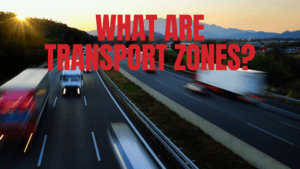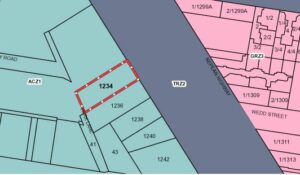07 Feb Transport Zones Explained

Is your property adjacent to a Transport Zone? Not sure what that means? Read on for information on how it might affect you.
When looking at a Planning Certificate or Zoning Map of your property, you might see that the land is adjacent to a different coloured road, like below:

Identifying if the site is adjacent to a Transport Zone
Before discussing what the Transport Zone means you need to know if it affects you. If you aren’t sure, I discuss how to find your planning controls in this article. Once you have done that you can come back for further information!
Categories of Transport Zones
The Transport Zone is used to delineate important transport infrastructure, this includes major roads and the rail network. The categories are as follows:
- Transport Road Zone 1 (TRZ1) – State transport infrastructure
- Transport Road Zone 2 (TRZ2) – Principal road network
- Transport Road Zone 3 (TRZ3) – Significant municipal road
- Transport Road Zone 4 (TRZ4) – Other transport use
What Does This Mean For You?
From a planning perspective applications adjacent or over these Zones may require additional scrutiny and be subject to external referral conditions. Early consideration of how access will be gained for your project is an important step, and you may need a Traffic Engineer to assist in the project.
The following controls apply:
- Works within TRZ1 and TRZ2 require consent from the Head, Transport for Victoria.
- A planning permit is required for displaying advertising signage over or within 600mm of a road. You can read more about signage controls here.
- A planning permit is also triggered for access and subdivision for land that is adjacent to a Transport Zone 2, see below for more detail.
Works or Subdivisions Adjacent to Transport Zone 2
Probably the most common planning triggers are for applications involving sites adjacent to TRZ2. These applications will be referred to Head, Transport for Victoria (if the related road is one managed by them). They are a determining authority, which means that if they object to the proposal the Council cannot approve it. If the road is managed by the Council the application will just be referred internally to the Traffic Department.
In particular for new vehicle crossovers, the main considerations will be:
- Will the entry and exit be safe?
- Is there another access point, such as a secondary road, that will be preferable (to them that is, not you)?
- Will the proposal result in significant additional traffic or other traffic implications?
It is quite common for them to impose conditions on residential development such as:
- Requiring all vehicles to exit the site in a forwards direction
- Requiring wider accessways to allow for two-way traffic at the property entrance
- Ensuring that basement ramps comply with a set gradient
It is not only applications involving a new or altered crossover that may be referred to Transport for Victoria, applications that are considered to change how that existing crossover will be utilised may also come under similar scrutiny. This means that if the crossover already exists, but you are introducing a change of use then the application may still be referred for comments.
What Type of Information Will You Need?
Depending on the type of project you may need to include the following information in your planning application:
- Plans detailing the design of the crossover and accessway.
- Details of traffic generated by the use.
- Ramp gradients, including a cross section.
- Swept path analysis to show vehicle movements.
- Road or traffic calming measures.
If your property is covered by or adjacent to a Transport Zone, particularly a Transport Zone 1 or 2 and you are thinking of building or developing you may want to speak to a Council, a Traffic Engineer or private Town Planner to see if there will be any implications for your property. We have managed many of these applications and understand the importance of early consideration of the traffic implications to maximise success for your project.

